I love ‘Regency’ and Empire fashions: the high waisted silhouette of the 1790s to the late 1810s.

Ladies’ Museum, Morning Dress for December, 1799.
However, my body does not. I’ve got small, firm, low-set breasts, very sloping shoulders, a relatively large square ribcage, and scoliosis. It’s a natural fit for 1910s, but not ideal for ca. 1800. Most of the bust supporting undergarments (whether they are stays, long or short, or jumps) of that 25-year span that I have made or tried on haven’t really worked for me. Some are literally painful: twisting my already twisted spine into unhappy positions, or trying to use my shoulders to yank my very-resistant-to-upwards-yanking bust up, and thus cutting into my shoulders. Others are just disappointing: flattening my bust into total nonexistence, or gaping sadly over each cup. Some seem OK at first, and then get progressively less comfortable over hours of wear.
I’ve felt like a total costuming failure with all my attempts at making Regency/Empire stays. Some have been so bad I haven’t even been able to make myself blog them. Some of it is my dislike of gussets, but mostly it’s my body, because my staymaking attempts have looked great on friends without my shoulder/ribcage/spine/bust issues.
When I’ve worn dresses of this era I’ve just cheated, using the dress itself to support me – with a small bust, it works OK, but it’s not ideal, and I don’t really end up with the right silhouette. And I end up with the same painful using-my-shoulder-to-yank-up-my-bust issue that the stays have had.
So one of my goals for this year is to make a pair of 1790s front-thrusting ‘transitional’ stays that really work for me, and a pair of ca. 1810 bust-separating Regency stays that also really work. I’m going to try every available pattern until I find the two best ones, and then do my best to perfect them for me (unless I get really lucky and manage to make something that is perfect the first try).
My first attempt was the View C short stays from J.S. Bernhart’s 1810 book, via the fantastic formula and research that Sabine of Kleidung um 1800 has done:
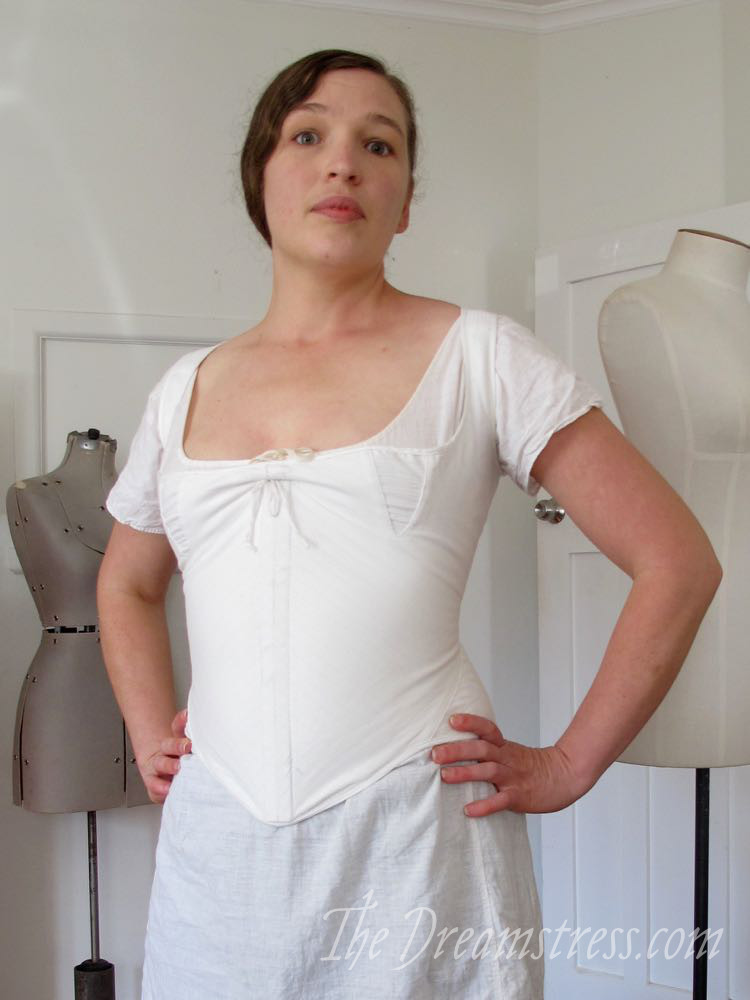
I’m actually pretty pleased with this pair. They have a couple of issues that need working out.
First, I need a longer busk – I haven’t been able to find the one I want in New Zealand. I’ve done the best I can and used a too-short option and sewn a channel for a wider busk as well as the narrow one shown here. I’ll order a couple from Redthreaded when I’m back in Hawaii in September.
Second, the pattern itself needs a little tweaking. I suspect the formula works really well at small sizes, and gets progressively less accurate as you get bigger. It’s definitely too big on me: the stays lace completely closed:
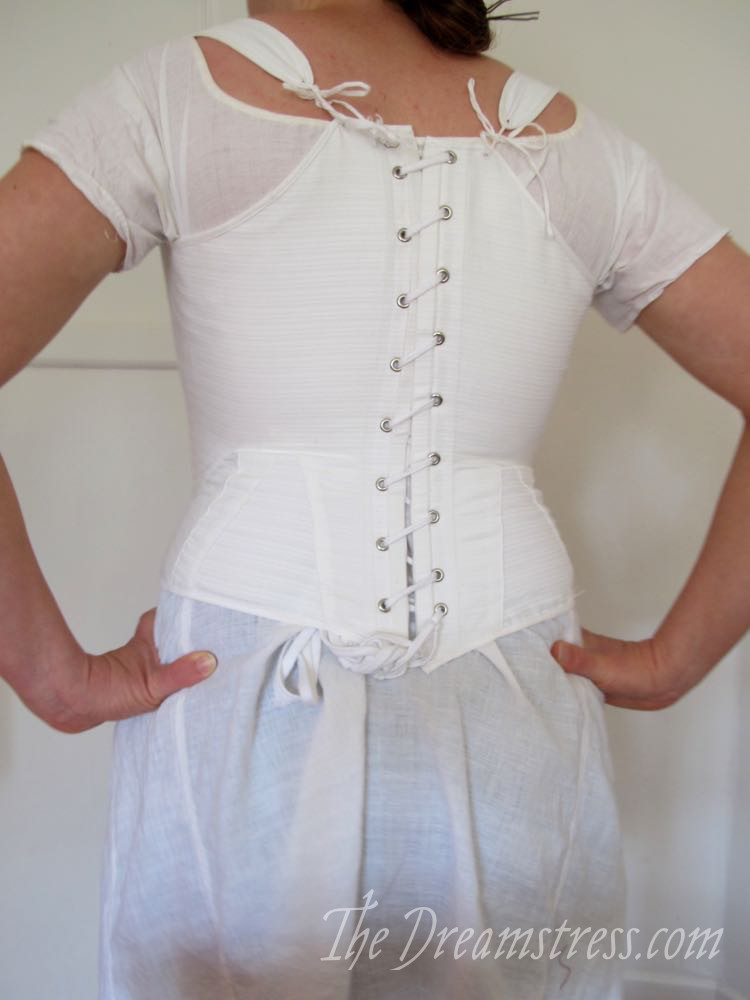
The straps angling in to the centre back are brilliant for my sloping shoulders, and really take the pressure off of them. However, if I want to wear anything with a lower back, they are too high, so I think I could tweak them to have a lower back, but straps that still angle inwards.
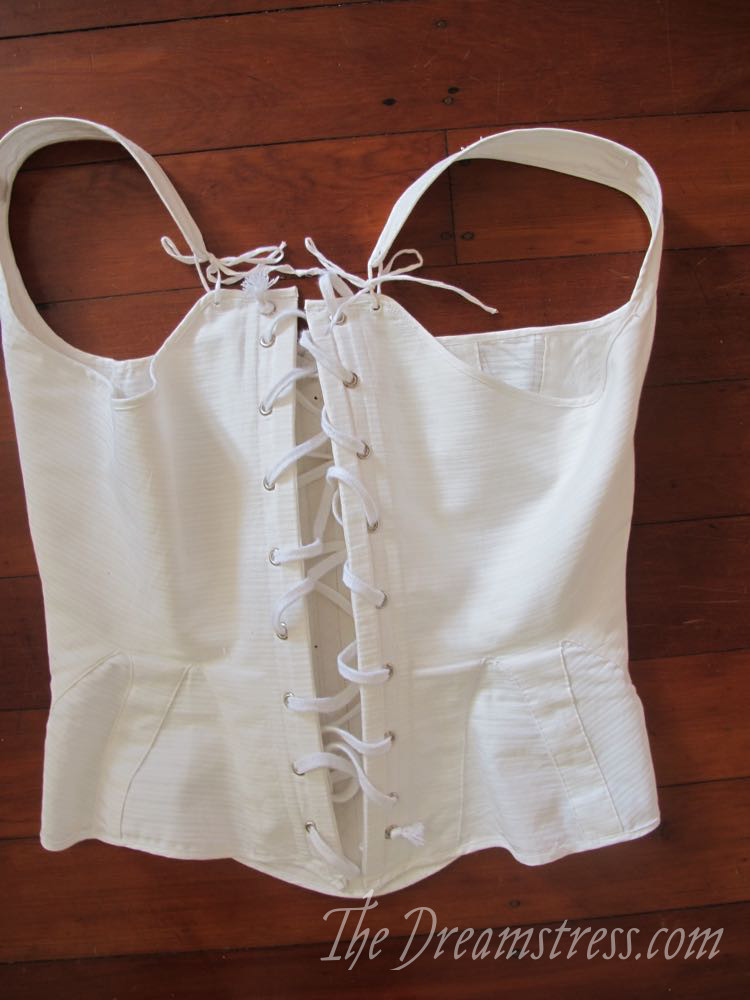
Simply making the pattern smaller may fix the next issue: separate breasts are all well and good, but I think my bust gussets are too far from the centre front.
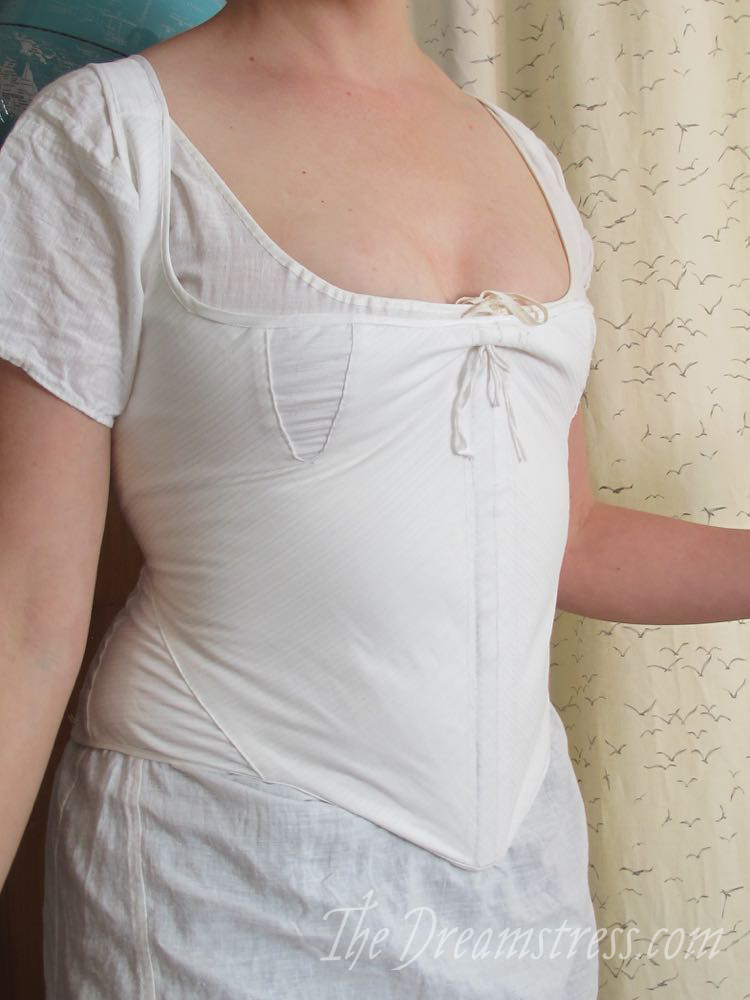
The final issue is the hip gussets. Sabine was super helpful in figuring out the size of my gussets, but I haven’t gotten them quite right. Bernhardt’s pattern is very much just a suggestion: my hip gussets are way bigger than Bernhardt’s suggestion, and still not quite big enough.
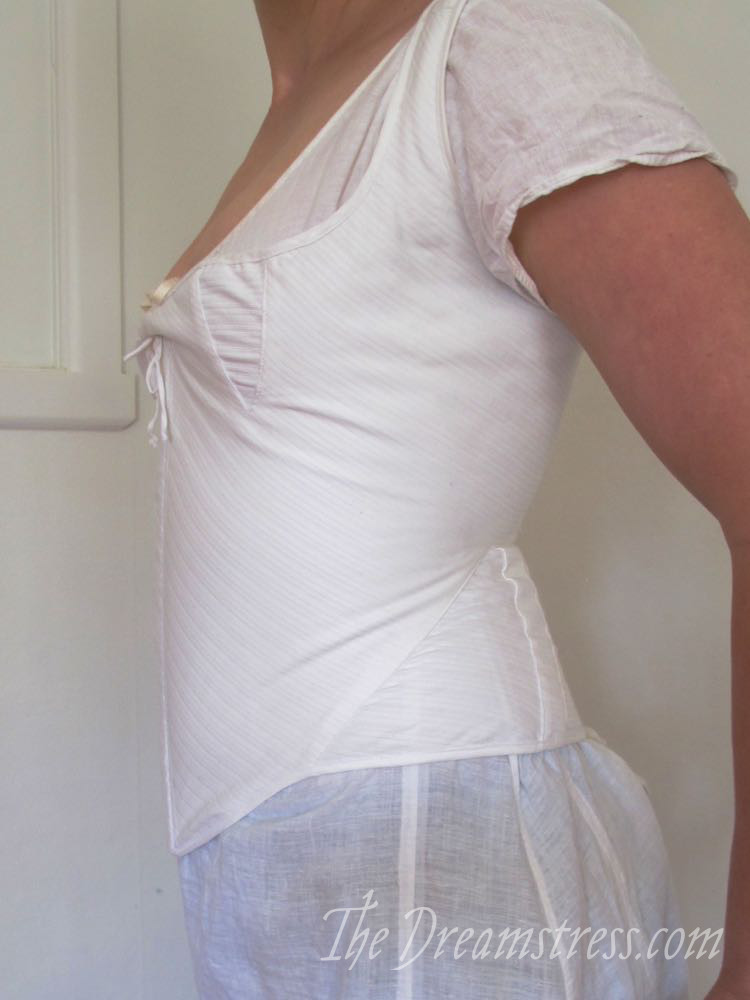
I think the hip gussets are also not quite at the right place – they would sit better right at the outward curve of my hip, instead of slightly to the back.
It’s almost as if the stays are too wide only at the front. If I took just an inch and a half out of the centre front seam, it would move the bust and hip gussets towards the front, and give me a lacing gap. I’m really tempted to do it, but am not looking forward to the binding issues that would create.
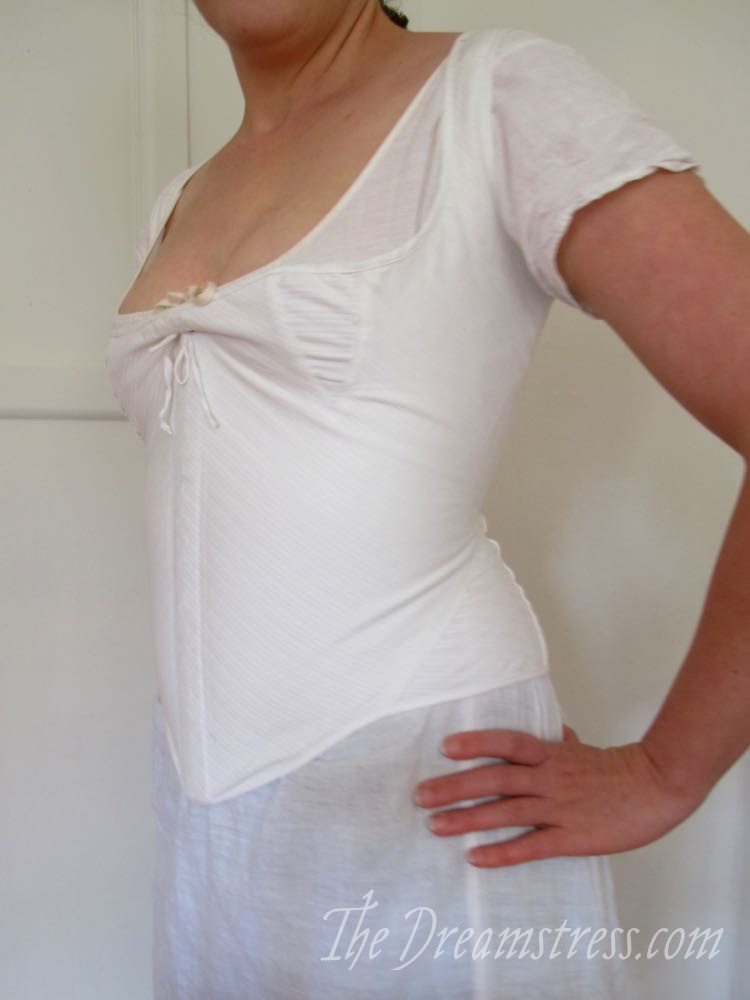
The other plan would be to simply make another pair, with the alterations. I did have these as a working-toile in my mind, which is why I used shortcuts like metal grommets.
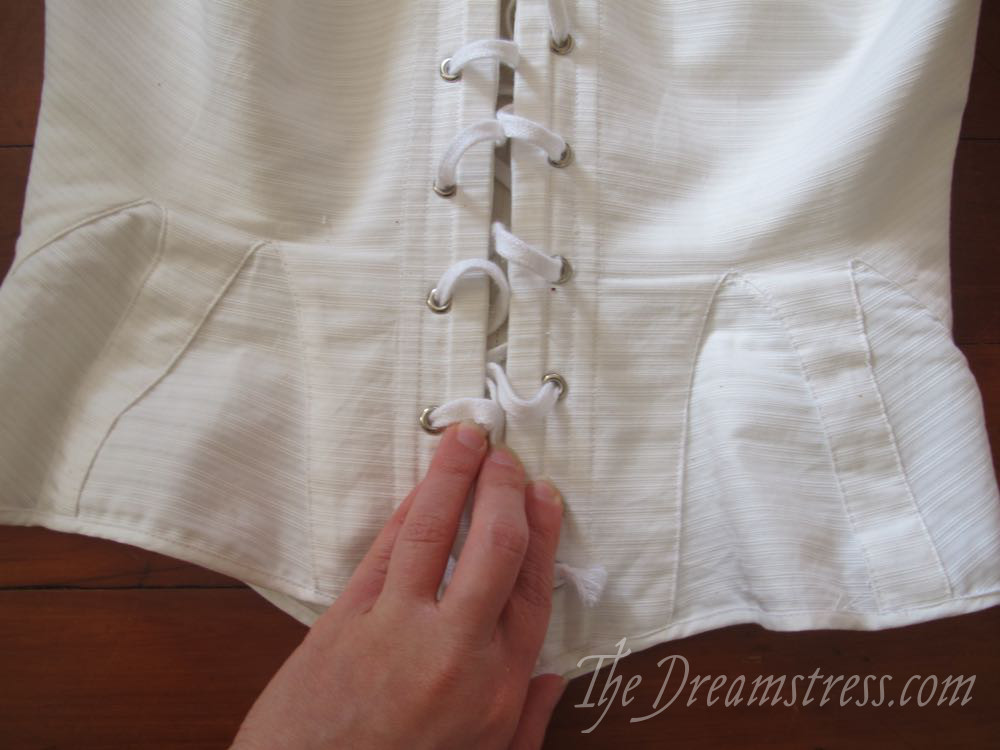
The Historical Sew Monthly Challenge #3: Comfort at Home
In any case, these were finished in time for the Historical Sew Monthly Challenge #3: Comfort at Home
What the item is: 1810s stays
Material: midweight linen (lining), midweight cotton twill (outer)
Pattern: J.S. Bernhardt’s short stays pattern C, as translated and gridded by Kleidung um 1800
Year: 1810
Notions: synthetic whalebone, wooden ruler, cotton thread, metal grommets, cotton lacing cord
How historically accurate is it? Construction wise, not so much – I used metal grommets, and sewed by machine. I also have no idea if my fabric is a correct match to this style of stays. I wanted to test the fit and wearability of these over time, and was less concerned with total accuracy of construction. Once I’ve got the fit totally sorted, I’ll make a more-close to accurate pair.
Hours to complete: 12 or so
First worn: For photos on the 30th of March
Total cost: $15 or so – the fabrics are all pieces I picked up for very little at op shops, the ruler was $1, the only real expense was a bit of boning and the grommets.


Hmmm, you certainly do have a lot of reasons to need a customized pattern. I look forward to seeing your journey through stays. I’d forgotten that this pattern Sabine made has straps that angle towards center back. That’s really quite smart for taking the pressure off the shoulders… but as you point out it limits the back options for dresses. Most of my dresses are patterned based on where my stays sit, which allows for wide necklines and low backs, but certainly wouldn’t work with this type of strap situation. But still, it’s intriguing… Maybe I need more dresses? LOL.
I look forward to seeing your journey through stays. I’d forgotten that this pattern Sabine made has straps that angle towards center back. That’s really quite smart for taking the pressure off the shoulders… but as you point out it limits the back options for dresses. Most of my dresses are patterned based on where my stays sit, which allows for wide necklines and low backs, but certainly wouldn’t work with this type of strap situation. But still, it’s intriguing… Maybe I need more dresses? LOL.
Best,
Quinn
I see what you mean about the gusset placement. Taking a couple of inches out of the centre front would make a big difference by the looks of it.
These look like a great first attempt! When I made mine (and I’m rather larger than you) I found I needed to removevwidth from center front and from the side/underarm area; shift the bust gussets toward the front; and cut down the center back edge. Once I did those things the stays fit much better. They are now my favorite design for a regency stays pattern! I also ended up adding extra bones diagonally from the side bust to the center front for more bust support.
I didn’t end up using a busk in mine; my protruding, round belly made it very awkward and uncomfortable. Instead I used bones, doubled in the cf channels. I’ve seen a few other makers of the Bernhardt stays that took this approach, too. Works like a charm! Very comfortable and supportive.
Thanks. I finally figured out my bust gusset were too far from the center. I am older large in the bust and my busk just doesn”t stay where it should large tummy. I will take it out. Thanks
What an interesting experiment! I agree with everything you say in the post, along with the comments. The front, especially, could use some shortening. Aren’t bodies neat?
Now I see it on a large screen, I see the fabric is subtly striped! Wow.
Okay, so I get through the SpamHaus from my father’s computer. Unfortunately, I only get here once in several months now.